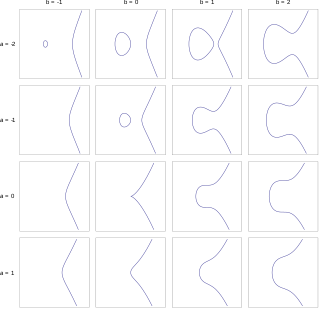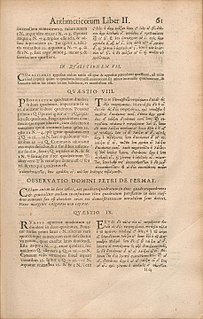
In mathematics, a Diophantine equation is a polynomial equation, usually in two or more unknowns, such that only the integer solutions are sought or studied. A linear Diophantine equation equates the sum of two or more monomials, each of degree 1 in one of the variables, to a constant. An exponential Diophantine equation is one in which exponents on terms can be unknowns.

In mathematics, an elliptic curve is a plane algebraic curve defined by an equation of the form

In mathematics, modular arithmetic is a system of arithmetic for integers, where numbers "wrap around" when reaching a certain value, called the modulus. The modern approach to modular arithmetic was developed by Carl Friedrich Gauss in his book Disquisitiones Arithmeticae, published in 1801.

Algebraic number theory is a branch of number theory that uses the techniques of abstract algebra to study the integers, rational numbers, and their generalizations. Number-theoretic questions are expressed in terms of properties of algebraic objects such as algebraic number fields and their rings of integers, finite fields, and function fields. These properties, such as whether a ring admits unique factorization, the behavior of ideals, and the Galois groups of fields, can resolve questions of primary importance in number theory, like the existence of solutions to Diophantine equations.
In number theory, the study of Diophantine approximation deals with the approximation of real numbers by rational numbers. It is named after Diophantus of Alexandria.
In mathematics, the Birch and Swinnerton-Dyer conjecture describes the set of rational solutions to equations defining an elliptic curve. It is an open problem in the field of number theory and is widely recognized as one of the most challenging mathematical problems. The conjecture was chosen as one of the seven Millennium Prize Problems listed by the Clay Mathematics Institute, which has offered a $1,000,000 prize for the first correct proof. It is named after mathematicians Bryan Birch and Peter Swinnerton-Dyer, who developed the conjecture during the first half of the 1960s with the help of machine computation. As of 2019, only special cases of the conjecture have been proven.
Chebotarev's density theorem in algebraic number theory describes statistically the splitting of primes in a given Galois extension K of the field of rational numbers. Generally speaking, a prime integer will factor into several ideal primes in the ring of algebraic integers of K. There are only finitely many patterns of splitting that may occur. Although the full description of the splitting of every prime p in a general Galois extension is a major unsolved problem, the Chebotarev density theorem says that the frequency of the occurrence of a given pattern, for all primes p less than a large integer N, tends to a certain limit as N goes to infinity. It was proved by Nikolai Chebotaryov in his thesis in 1922, published in.
In mathematics, complex multiplication (CM) is the theory of elliptic curves E that have an endomorphism ring larger than the integers; and also the theory in higher dimensions of abelian varieties A having enough endomorphisms in a certain precise sense. Put another way, it contains the theory of elliptic functions with extra symmetries, such as are visible when the period lattice is the Gaussian integer lattice or Eisenstein integer lattice.
In mathematics, Ribet's theorem is a statement in number theory concerning properties of Galois representations associated with modular forms. It was proposed by Jean-Pierre Serre and proven by Ken Ribet. The proof of the epsilon conjecture was a significant step towards the proof of Fermat's Last Theorem. As shown by Serre and Ribet, the Taniyama–Shimura conjecture and the epsilon conjecture together imply that Fermat's Last Theorem is true.

In mathematics, a congruent number is a positive integer that is the area of a right triangle with three rational number sides. A more general definition includes all positive rational numbers with this property.
In number theory, the Erdős–Straus conjecture states that for all integers n ≥ 2, the rational number 4/n can be expressed as the sum of three positive unit fractions. Paul Erdős and Ernst G. Straus formulated the conjecture in 1948. It is one of many conjectures by Erdős.
In number theory and algebraic geometry, a rational point of an algebraic variety is a point whose coordinates belong to a given field. If the field is not mentioned, the field of rational numbers is generally understood. If the field is the field of real numbers, a rational point is more commonly called a real point.

In number theory, a congruum is the difference between successive square numbers in an arithmetic progression of three squares. That is, if x2, y2, and z2 are three square numbers that are equally spaced apart from each other, then the spacing between them, z2 − y2 = y2 − x2, is called a congruum.

In number theory, Fermat's Last Theorem states that no three positive integers a, b, and c satisfy the equation an + bn = cn for any integer value of n greater than 2. The cases n = 1 and n = 2 have been known since antiquity to have infinitely many solutions.
An important aspect in the study of elliptic curves is devising effective ways of counting points on the curve. There have been several approaches to do so, and the algorithms devised have proved to be useful tools in the study of various fields such as number theory, and more recently in cryptography and Digital Signature Authentication. While in number theory they have important consequences in the solving of Diophantine equations, with respect to cryptography, they enable us to make effective use of the difficulty of the discrete logarithm problem (DLP) for the group , of elliptic curves over a finite field , where q = pk and p is a prime. The DLP, as it has come to be known, is a widely used approach to public key cryptography, and the difficulty in solving this problem determines the level of security of the cryptosystem. This article covers algorithms to count points on elliptic curves over fields of large characteristic, in particular p > 3. For curves over fields of small characteristic more efficient algorithms based on p-adic methods exist.
In mathematics, the main conjecture of Iwasawa theory is a deep relationship between p-adic L-functions and ideal class groups of cyclotomic fields, proved by Kenkichi Iwasawa for primes satisfying the Kummer–Vandiver conjecture and proved for all primes by Mazur and Wiles (1984). The Herbrand–Ribet theorem and the Gras conjecture are both easy consequences of the main conjecture. There are several generalizations of the main conjecture, to totally real fields, CM fields, elliptic curves, and so on.
In arithmetic geometry, the Tate–Shafarevich groupШ(A/K), introduced by Serge Lang and John Tate (1958) and Igor Shafarevich (1959), of an abelian variety A (or more generally a group scheme) defined over a number field K consists of the elements of the Weil–Châtelet group WC(A/K) = H1(GK, A) that become trivial in all of the completions of K (i.e. the p-adic fields obtained from K, as well as its real and complex completions). Thus, in terms of Galois cohomology, it can be written as
In mathematics, elliptic curve primality testing techniques, or elliptic curve primality proving (ECPP), are among the quickest and most widely used methods in primality proving. It is an idea put forward by Shafi Goldwasser and Joe Kilian in 1986 and turned into an algorithm by A. O. L. Atkin the same year. The algorithm was altered and improved by several collaborators subsequently, and notably by Atkin and François Morain, in 1993. The concept of using elliptic curves in factorization had been developed by H. W. Lenstra in 1985, and the implications for its use in primality testing followed quickly.
In mathematics, the arithmetic zeta function is a zeta function associated with a scheme of finite type over integers. The arithmetic zeta function generalizes the Riemann zeta function and Dedekind zeta function to higher dimensions. The arithmetic zeta function is one of the most-fundamental objects of number theory.
In mathematics, the rank of an elliptic curve is the rational Mordell–Weil rank of an elliptic curve defined over the field of rational numbers. The rank is related to several outstanding problems in number theory, most notably the Birch–Swinnerton-Dyer conjecture. It is widely believed that there is no maximum rank for an elliptic curve, and it has been shown that there exist curves with rank as large as 28, but it is widely believed that such curves are rare. Indeed, Goldfeld and later Katz–Sarnak conjectured that in a suitable asymptotic sense, the rank of elliptic curves should be 1/2 on average. In other words, half of all elliptic curves should have rank 0 and the other half should have rank 1; all remaining ranks consist of a total of 0% of all elliptic curves.









